HVAC Training Shop is reader-supported. As an Amazon Associate, I earn from qualifying purchases.
Portable air conditioners need regular maintenance to function properly. Among them, draining the condensate tank is an important task to keep your portable AC running.
The frequency that you drain your portable air conditioner depends on the conditions of the air inside your home.
In this article, I’ll discuss how often you need to drain your portable air conditioner. We’ll also take a look at what happens if you don’t drain your portable air conditioner.
How often should you drain your portable AC?
Depending on the humidity in your space, you will need to drain your portable air conditioner as often as every 8 hours. However, you usually won’t need to drain your portable air conditioner this often.
If you live in a dry area, then you will rarely need to drain your portable air conditioner. This is because the water that fills your portable air conditioner is extracted from the cooling of warm humid air. If the air in your space is dry, then the air conditioner won’t pull any moisture out of the air.
Most modern portable air conditioners are able to completely remove moisture from your home using the exhaust vent. To do this, the air conditioner sprays water from its condensate tank onto the condenser coil. As the condensate comes into contact with the hot condenser coil, it evaporates. The vapor is then blown out of your house through the exhaust hose.
Most times, this method is able to get rid of the water from your portable air conditioner’s condensate tank. However, if the humidity in your home is excessively high, your portable AC won’t be able to evaporate all the water. Only in humid climates will your portable air conditioner’s tank need to be emptied regularly.
Even if you live in a dry area, you need to make it a habit to check your portable AC’s tank at least once a month. It will give you a chance to inspect your portable air conditioner’s tank for any signs of mold.
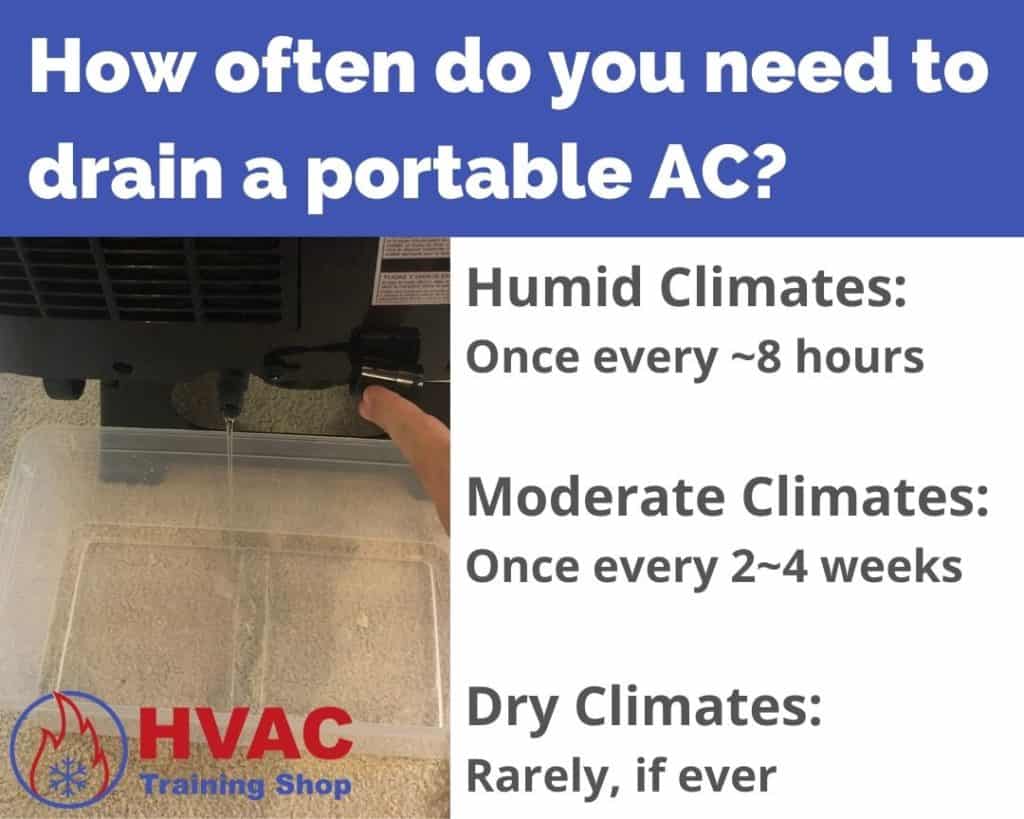
What happens if you don’t drain your portable air conditioner
If you don’t drain your portable air conditioner, a few things can happen:
- The portable air conditioner will shut off and not turn back on. This is the most common outcome. Most portable air conditioners have a built-in float switch. The purpose of the float switch is to turn off the air conditioner if its condensate tank fills up with water. When an air conditioner has a full tank, then it is usually accompanied by an alarm that will alert you of its status. That way, you’ll know it’s time to drain the tank.
- The condensate tank will overflow. If your portable air conditioner’s float switch is not working, then you run the risk of water overflow. This is not a huge problem in and of itself, except that it can cause water damage to your home.
- Mold will grow in your portable air conditioner. Most people don’t consider that mold can grow in their AC. Mold growth happens especially in portable air conditioners that are not emptied. If water is left inside your portable AC’s tank, it creates a moist environment that is perfect for a mold colony to grow in.
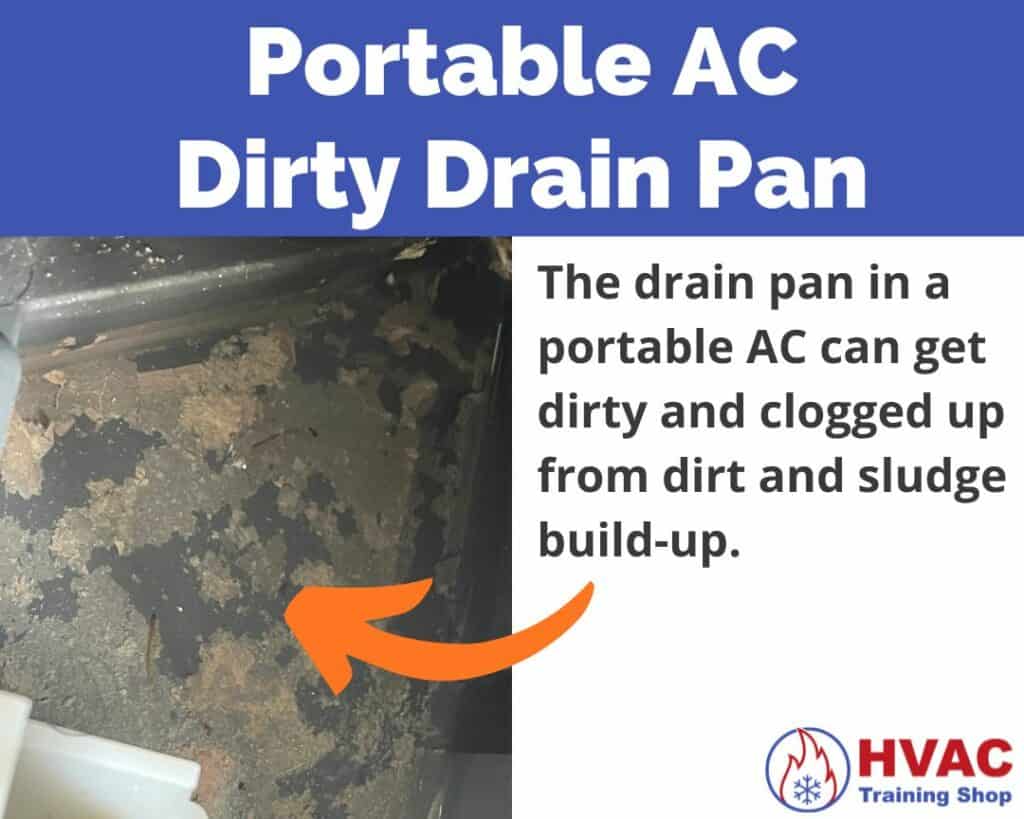
Why your portable air conditioner is producing so much water
A portable air conditioner that produces a lot of water is nothing to be worried about. Well, most of the time anyway.
Air conditioners produce water as they cool your home’s warm air. As your home’s air is cooled, water precipitates out of the air and is collected in a tank in the AC.
In fact, this method of removing water from the air is how dehumidification works.
If your portable air conditioner is producing more water than it usually does, it is because your room’s air is more humid than usual.
This can be due to internal or external factors:
- Internal: Activities such as cooking and using the shower will generate humidity. If you have a lot of guests over, then the humidity can increase from all the people breathing inside your home.
- External: Humidity can come from outside your home as well. If the weather outside is warm and humid, then your air conditioner will produce water as it cools and dehumidifies the warm moist air.
The production of water is a good sign that your air conditioner is functioning correctly. But if it is producing more water than usual, that can be a sign that there is a source of humidity that is infiltrating your home’s air.
In this case, you’ll need to find the source of humidity and remove it. One source of excess humidity is the infiltration of outside air into your home. Gaps around windows and doors can let warm moist air from the outside into your home.
Be sure that you seal all the gaps in your home to not allow outside air and humidity to get inside.
How long can you run a portable air conditioner continuously?
The short answer is that you can run your portable air conditioner continuously without much issue. As long as you clean the air filters and empty the condensate tank, you can pretty much run your air conditioner all season long.
But that doesn’t mean that you should just leave your AC on all the time. Like most mechanical equipment, it is a good idea to give your portable AC periodic breaks. Turning off your portable air conditioner gives it a chance to cool down and stop wear on its parts.
Regardless if you turn your AC off, it should turn itself off periodically after it cools a room. A sufficiently sized air conditioner will run in 10-20 minute intervals as it cools your room down to the temperature setpoint.
If your portable air conditioner runs constantly, then it may be undersized for the room. There may also be extra sources of heat or moisture that need to be isolated from the room. In both cases, a larger portable air conditioner will cool your room quicker and more efficiently.
Continuous drain setup for portable air conditioner
If you want your portable air conditioner to continuously run, then you’ll need to set up a drain hose.
The drain hose empties water from the condensate tank automatically. One side of the drain hose attaches to the condensate tank and the other side goes to a drain. You can also direct the condensate hose outside to drain.
Using a drain hose will prevent your condensate tank from accumulating water. With this setup, you won’t need to worry about emptying the condensate tank.
But you’ll still want to keep an eye on your portable AC. The inside of the portable air conditioner will still be a little wet from the condensate. Remember to check for mold and clean the filters at least once a month.

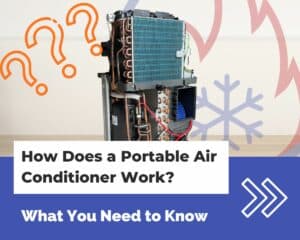
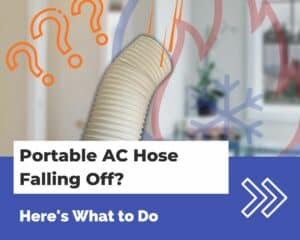
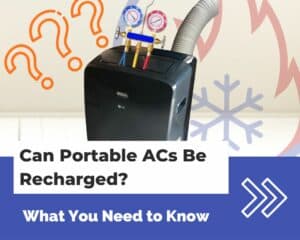
I have a portable air condition in a small 8×12 shed we finished off for my teen to use as an apartment. So Florida is very humid, and on cool mode we have to empty the tank every couple hours. Im thinking I should drill to set up continuous drainage so we don’t have to keep draining it… any better ideas?
Hi Matt,
A continuous drainage setup is your best bet if you don’t want to keep emptying the portable AC.
Another option would be to install a window unit. In addition to not needing to drain, window units are generally more energy efficient.
Hope this helps,
-Trey
– Hi Trey,
great advice & support in this column, advice. awesome.
soo I have a serenlife blah blah blah Mobile AC Unit, BTU: 10K (this is how much I do know, it was brought by a family member) I’ve heard of them before. 1st time dealing with them. currently me & wife are in a smaller residential dormitory. now I’ve noticed when I run the Unit for awhile it’ll shut off and the CODE on the small screen will read E5. I have no idea what the heck that means. soo I did what others generally do. researched, it said something about Power – Power not enough ?? something along those lines. Again I Repeat this is all Greek To Me. to but it bluntly we live in an Apartment Residence ( yes, I know this help is mostly for HOME OWNERS. lol ) but you appear to be more knowledgable then me traveling all over online looking for answers constantly..all I keep getting is soccer mom responses, men who have zero clue about HVAC Systems (this includes myself) Lol. I want / need a real answer or something to consider as strong Advice-support help . It doesn’t do this all the time. but this is since I’ve used it. actually let me be frank: soo early in the morning, I retired to bed; woke up (at least 4 – 4.5 hours past) while asleep and the Unit displayed that code E5. didn’t know what to make of it. ( to be clear I never did this since I had the unit) soo my first time leaving the machine running that long – then waking up to see this Code. did an Online research and I followed suit. unplugged the unit for well over 30 + minutes then re-plugged it back in. also to note I just recently found / discovered that you NEED to change / adjust the Condensate Tank. ( again, thank you Trey. Lol) soo . now here we are:
– I’m worried that this will happen again. however as I’m writing to you right now. its running and its 77+ Degrees ( thats not too hot for me; I Was born during a summer heat wave. he he. any solutions ? could this be a potential future on going problem ? and did a friend / family member wasted money on this Machine, due to its functionality ?
– Again thank you for all help & advice. Sir’
Signed’ Mr. K Brown
Hi Kenneth,
I did a search for a Serenelife error E5 and couldn’t find anything. What is the exact model number for your portable AC? It should be printed on a sticker somewhere on the exterior of the unit.
It sounds like you already emptied the AC’s condensate tank. So one other thing that you should do is clean the air filters for the portable AC and ensure that the exhaust hose is not clogged, kinked, or obstructed in any way.
Hope this helps
-Trey
Are you sure it’s not E8 which means clean filter
I am setting up my Wynter ARC-110WD. It did not come with a drain hose. I love in Washington State and the humidity is high.
Where will I get a hose and how do I install it? There are no instructions for this in the manual.
Hi Deborah,
This is the drain hose for that model. However, it doesn’t look like its in stock right now, you might need to contact the vendor to see when it will be back in stock.
It has a seal that connects to the portable AC, so i’m not sure if any other generic brands will work either.
Best of luck,
-Trey
What about a bottom drain hose?
Hi Deborah,
Your Whynter portable AC is a self-evaporating unit, so its continuous drain hose needs to be attached to the top port. The bottom drain port is used to drain the unit for storage.
I have written an article about portable ACs with two drains here: https://hvactrainingshop.com/why-does-portable-ac-have-two-drains/
Hi Trey,
Thank you for this guidance.
What would be the best way to keep the inside of the AC free of mold if the AC rarely needs drainage? The opening for the water to pour out of is such a small hole – how would you determine if there is mold growing inside? Last summer, our unit was drained very infrequently and the notification never went off. Of course, prior to storage, it was drained as best as possible (we did not tilt it to empty it – I’m not sure now if we should have) and the fan was run afterwards. It was then covered and stored away. Is it possible that mold has grown in the unit the past year while it was stored due to infrequent drainage? Thank you!
Hi Sana,
Whether your unit has mold after storing it for a year depends on all sorts of factors. I’m not sure about your specific unit, but you can try opening up the portable AC to inspect its drain pan to see if it has mold.
Hope this helps,
-Trey
I just bought a portable ac unit and I have needed to drain the water from the tank almost every hour. It is brand new and it’s not particularly humid where I live. Should I return the unit as defective?